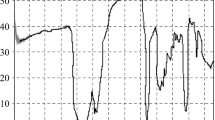Abstract
Preparation and adsorption specificity of tannins immobilized by covalent binding on water-insoluble matrices were investigated. Immobilized tannins were prepared by condensing cyanogen bromide activated tannins with aminohexyl derivatives of several kinds of matrices. The most suitable matrix for the immobilization of tannin was alkali-treated cellulose powder. The concentration of sodium hydroxide solution for alkali treatment influenced the adsorption capacity of immobilized tannin for a protein, but temperature and time for alkali treatment did not. Immobilized tannins having spacers of long chain length exhibited high adsorption capacity for a protein. Chinese gallotannin was the most favorable ligand for protein adsorption. The immobilization of tannin on aminohexyl matrices was also possible by using epichlorohydrin instead of cyanogen bromide. The maximum adsorption capacity of the immobilized tannin for a protein was about 50 mg/ml of the absorbent. Immobilized tannin adsorbed proteins specifically but did not absorb low molecular weight compounds.
Similar content being viewed by others
References
Grant, R. A. (1974) Process Biochemistry 9: 11–14.
Messing, R. A. (1974) Brewers Digest 46: 60–63.
Atkinson, A. (1973) Process Biochemistry 8: 9–12.
Baum, G., andLynn, M. (1973) Process Biochemistry 10: 14–17.
Tosa, T., Sano, R., Yamamoto, K., Nakamura, M., andChibata I. (1972) Biochemistry 11: 217–222.
Cuatrecasas, P. (1970) J. Biol. Chem. (1970) 245: 3059–3065
Porath, J., andFornstedt N. (1970) J. Chromatogr. 51: 479–489.
Inman, J. K., andDintzis, H. M. (1969) Biochemistry 8: 4074–4082.
Hoare, D. G., andKoshland, D. E. (1966) J. Amer. Chem. Soc. 88: 2057–2058.
Hoare, D. G., andKoshland, D. E. (1967) J. Biol. Chem. 242: 2447–2453.
Masaharu, K. (1949) Yakugaka Kenkyu 21: 129–132.
Lowry, O. H., Rosebrough, N. J., Farr, A. L., andRandall, R. J. (1951) J. Biol. Chem. 193: 265–275.
Cadavid, N. G., andPaladini, A. C. (1964) Anal. Biochem. 9: 170–174.
Somogi, M. (1945) J. Biol. Chem. 160: 61–68.
Bock, R. M., andAlberty, R. A. (1953) J. Amer. Chem. Soc. 75: 1921–1925.
Goodman, A. E., andStark, J. B. (1957) Anal. Chem. 29: 283–287.
Kennedy, J. F. (1974) Adv. Carbohydr. Chem. Biochem. 29: 305–308.
Wilchek, M., andMiron, T. (1976) Biochem. Biophys. Res. Commun. 72: 108–113.
Watanabe, T.,Fujimura, M.,Mori, T.,Tosa, T., andChibata, I. (in press) J. Appl. Biochem.
Watanabe, T., Mori, T., Tosa, T., andChibata, I. (1979) Biotech. Bioeng. 21: 477–486.
Author information
Authors and Affiliations
Rights and permissions
About this article
Cite this article
Watanabe, T., Matuo, Y., Mori, T. et al. Preparation of immobilized tannins for protein adsorption. Journal of Solid Phase Biochemistry 3, 161–174 (1978). https://doi.org/10.1007/BF02991844
Accepted:
Issue Date:
DOI: https://doi.org/10.1007/BF02991844




